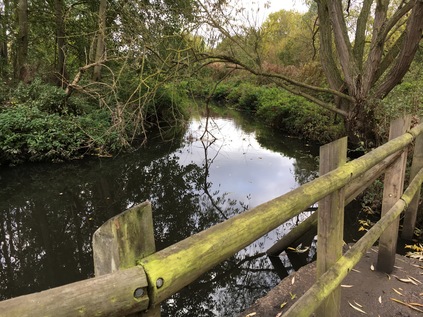
London's Green Fringe: The River Ingrebourne
Posted in London on Saturday 5th November 2016 at 10:11pm
I stood, shivering at the bus stop in the middle of a group of mildly disgruntled passengers. We'd been here for a while, despite being told that the replacement bus service was 'just around the corner' several times. A Transport for London employee conversed urgently with a representative of Ensign Buses who was nervously checking his smartphone screen frequently. A light drizzle started to fall. I hadn't begun my walk yet - but I was already close to turning on my heel and heading back to the city. It hadn't been a great start - the slow slog along the alternative route from Bath to Paddington had been a minor irritation - arriving a half-hour later than usual in London was tolerable in itself. I also knew that the line from Liverpool Street to Shenfield was closed for platform lengthening work - and I'd factored that into my plans. I'd be putting boots on the ground much later than I'd usually plan to be, but if I pushed through the range anxiety which a late start causes, I could still manage the planned route. I'd even managed to commit an annoying cold to the back of my mind - I was still coughing furiously at times, but considering I'd only been nursing the symptoms for a few days, I felt surprisingly ready to tackle a walk. But now I was stranded in Chadwell Heath, an unprepossessing corner of Greater London which has Essex aspirations but none of the means to back it up. A bus finally lurched up to the stop - but another train had arrived now and a stream of passengers ambling along the footpath broke into a trot at the sight. Those of us already at the stop crammed desperately onto the double-decker the moment the last straggler had cleared the decks. The bus was warm and reeked of wet coats and over-deployed aftershave, its windows dripping condensation already from the fresh crush of humanity on board. We set off through the long sprawl of takeaways and suburban pubs towards Romford where the bus mercifully decanted most of the passengers. A few of us soldiered on east - along the curiously named Squirrels Heath Lane towards Harold Hill. This is where I would start - at Harold Wood station on the very fringe of built-up London, an area which until 1965 was resolutely part of southern Essex and has continued some of the less savoury traditions - not least the curiously violent history of the area, with numerous unrelated murders and attacks over the years. Now, it's on the up again - the large swathe of post-war residential areas is improving and the little parade of shops outside the station was busy and varied. A local initiative known as Harold Hill Ambitions oversees the regeneration. For now though, my own somewhat humbler Harold Hill ambition was simply to start walking. Later than I'd like and still with some concern I'd struggle to complete the route today, I headed up the slope by the closed station where a long bus queue was developing for the next heaving double-decker to Chadwell Heath. It was time to set off in earnest.
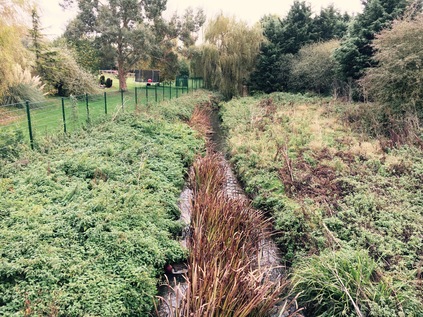
Once I'd set off and settled into the welcome rhythm of walking, my mood improved. I'd almost forgotten the purpose of today's walk - to chart the course of the tiny Ingrebourne River, one of the easternmost tributaries of the Thames to run through Greater London. It begins its surprisingly long journey out in Essex, on the fringes of Brentwood where it meets the Weald Brook before turning east, passing under the M25 and skirting Harold Wood. I'd looked at the possibility of starting my walk further out near the Motorway - but transport beyond the railway was sparse and time was now a limiting factor. Instead, I turned east after crossing the railway into the quiet backstreets of Harold Wood. A corner store selling car paint was decked out with England flags and UKIP stickers and I fought hard to push the preconceptions away. Here on the fringes of London lies this outer band of economically challenged but just-managing communities which edge a vast city of diversity and change. It's unfair to characterise this as an Essex phenomena - the halo of intolerance circles the city. But here on the eastern edges it sometimes feels more concentrated and close to explosion. I turned onto an unadopted gravel road which ran between lines of suburban semis and allotments. A bonfire crackled beyond the fence, while a group of dedicated diggers prepared their plots for winter. At the end of the track I was deposited onto a surprisingly busy minor road - the continuation of Squirrels Heath Road as it headed over the edge of London. A little to the east a low brick parapet gave away the location of the Ingrebourne at Cockabourne Bridge. The brook was bright and clear here, running over a stony bed and between green, wooded banks. To the east, Shepherd's Hill rose into Essex with a string of car headlamps shining in the gloomy morning. I zig-zagged across the lane and into a narrow driveway leading to Harold Wood Park, before turning east and finding the line of the Ingrebourne beyond the changing rooms and tennis courts. A path crossed the river and turned south - I took it and suddenly found myself out of London entirely. The city felt impossibly and completely distant. The air was clear and quiet, and the sky was a band of grey with a promising flash of blue beyond. As I walked, following the twisting course of the river in its green trench, I realised I was entirely alone out here. The dog walkers had evaporated away towards the car parks, and the only sound was the satisfying crunch of my boots hitting the path on the edge of the woods. I let my pace slacken a little, enjoying the sense of isolation and savouring the pangs of uncertainty which always hit when I feel I've left the gravity of London involuntarily. The morning was surprisingly mild and was staying dry. I wasn't sure what I'd expected of the tiny Ingrebourne but this was a surprise.
As the Forestry Commission's well-maintained path divided I was faced with a choice: head west, and leave the course of the river to detour into more urban territory before regaining its route, or to head east and stick a little closer to the water. I turned east and soon found myself on the busy rat-run of Hall Lane. Despite being a relatively minor and almost rural route, this lane provides a back route between the suburbs of Harold Wood and the larger urban centre at Upminster, crossing the busy A127 Southend Arterial Road at a sprawling junction. The brief section I walked was busy with vehicles but thankfully supplied with a decent footpath. The lane rose gently as I walked south with farmland to the east, and a view over the surprisingly deeply carved valley of the Ingrebourne to the west. Across the valley I could see the distant spire at Hornchurch and stubby towers of housing dotting the hills towards Romford. It felt odd to be looking in on London like this, seeing it as the next village over the hill. A growing hum proved to be traffic on the A127, carving in from the east in a deep gully with sweeping slip roads joining my route here. I climbed the curving path beside the litter-strew bank to find myself above the main carriageway. The rush of traffic was oddly exhilarating after the silent countryside, and the views towards the west suddenly revealed the distant misty shades of London's city skyline which felt alarmingly remote. After descending from the overbridge my path left Hall Lane briefly to skirt the access drive to a row of large, very expensive looking villas with a range of luxury cars in their drives. The link between the wealth of the distant city towers and the assets arrayed along this quiet lane was suddenly very clear and very direct.
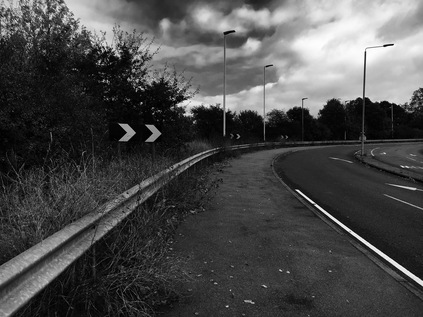
The footpath along Hall Lane was officially part of the London Loop path, which I'd find myself following fairly faithfully from here onwards. I was a little ambivalent about this - my walks were supposed to follow the topographical and historical pathways I was curious about and I met all too many people who were set on covering the various mapped and signposted footways around Britain as something of a ticking-off exercise remote from any local interest. I'd been asked "are you doing the London Loop?" often enough to somewhat shudder at the rather glib, middle-class 'in group' of walkers who hefted their poles and wore designer ski-wear to navigate paths within the M25. I also imagined that the London Loop was, like much of the Thames Path, a greatly improved and well-appointed route which would be busy with walkers at all times. This wasn't always what I wanted, and I'd grown used to solitude on these rambles. My experiences over the next hour were to challenge all of those assumptions - and to diminish some of the snobbery I'd somehow found myself deeply mired in, exchanging it for honest English mud. I left Hall Lane to gingerly totter down the steep hill of River Drive. This was a street of fine mid-century houses which climbed down the steep edge of the Ingrebourne Valley between vintage lampposts to meet woodland at the end of the cul-de-sac. When I reached the bottom I squeezed through a narrow gate with a London Loop marker on it, and plunged deep into woodlands. The trees closed over me, and the floor was a sea of autumn leaf-fall. It was eerily quiet and pleasantly cool as I pressed on, thankful for my good boots and treading very carefully over the buckling roots of trees which crossed the path. For a good distance, the path was only a footstep wide, my left boot splashing into a shallow stream which had carved deeply into the muddy ridge on which my right foot was determinedly plodding. I realised that this was some unmarked tributary of the Ingrebourne, which I was soon to cross on its own narrow wooden bridge. The river was still flowing fast and clear here - a reassuring presence after a rather sudden venture into wilder lands. My path continued, sweeping to the south and into a field of horses which I assiduously avoided. Looking back, the rising woodland sloped away into the distance, back to my starting point at Harold Wood and beyond. Ahead, the still remote church tower slipped across the horizon as I edged around recently harvested stubble-fields on a rough and narrow pathway. This was more challenging than I'd imagined my walk, and much less 'improved' than I'd suspected the London Loop would be. Oddly though, I found myself entirely enjoying this surprisingly rural edgeland ramble. I could see the built-up fringes of Upminster beyond a distant school field and the rough walking was exhilarating. I left the path to stalk through some longer grass to the river's edge, speculating that this would have been tougher going in the Summer as I trudged over decaying nettles which would have been a waving field of potential stings just a month or two back. Eventually, the footpath ended beside an allotment and turned a corner into a litter-strewn gravel drive between some concrete garages. While I was sorry to leave the open fields behind, I was hungry and flagging a little, so civilisation was almost welcome as I navigated the backstreets to Upminster Bridge with its little cluster of shops around the penultimate station on the District Line. I grabbed a snack and headed over the river once again at a noticeable depression in the road which marked its valley.
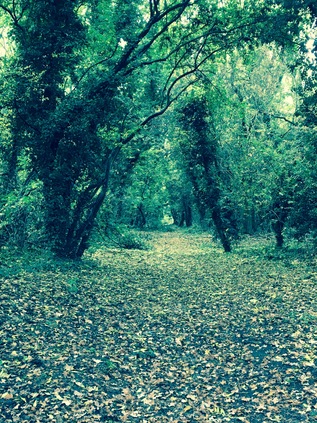
I was eager to find the Ingrebourne again, so I swiftly turned south into the quiet of Bridge Avenue which skirted the edge of Hornchurch Stadium, home to the local football club. The footpath I needed to pick up ran through the club's almost deserted gravel car park, entering a public park via a low gate and becoming Gaynes Parkway - a long, green route through the edges of Upminster which followed the river tightly. After a pause for lunch in the park on a convenient bench, it was good to be walking at some pace again. While the scramble through the woods had been surprisingly good fun, it was slow going and I'd begun to feel the pressure of time again. I recalculated the spots I could practically turn aside if time was short - but there were rather few from here onwards, and striking out for Rainham was by far the best option possible. The path was deserted in the grey afternoon, and I was able to stay close to the meandering Ingrebourne for a unusually long distance as it tumbled over weirs and through concrete channels designed to calm its flow when in spate. As the view broadened into a wide sweep of grassland to the east, the river divided into a number of channels and unnamed tributaries. The Ingrebourne's final stretch is a lazy wander through the flat bottom of a broad valley, where it spreads to feed wetlands and marshes hemmed in by higher ground. Much of the area has become Hornchurch Country Park, largely centred on the former RAF Hornchurch. This was the home of the squadrons of Spitfires which valiantly defended London's skies during World War II, but has a longer link to aviation. A giant iron RAF roundel set into the ground outside the Ingrebourne Valley Visitor Centre is inscribed with the dates of Sutton's Farm - a First World War airfield which requisitioned a large part of a local farm, but closed in 1920 and returned to peaceful pasture. The site was requisitioned once again in 1928 for the larger fighter base which survived until 1962, well into the jet age. Passing up a chance to explore the Visitor Centre and its inviting café due to my tight schedule, I pressed on into the park. A little weak sunshine was beginning to filter through the clouds in broad shafts, striking the wooded hills to the east with patches of bright autumnal gold. The path was busy with walkers, families on cycles and lots of dogs, and it was pleasant to be making a good pace despite tired feet. The former military role of the land was marked by the ominous concrete pill boxes and gun emplacements which were half-buried in grass. Their stark, empty faces now inert but a reminder that this was to a great extent the last line of defence for London. It was sobering to think how London had become a city under siege again back in 2012 and how normal it felt now to see armed police around the city. Strange times sometimes hark back to even stranger eras it seems. Deeper into the park, the stream of walkers thinned and only a few more dedicated souls passed me by. The path took an abrupt westerly turn to skirt the lake at Albyns Farm, dotted with tiny islands which waterfowl flitted between. The path soon turned into a narrow road which led to the farm houses. The impressive houses sat behind high electric gates, an array of expensive vehicles ranged along a rank of large garages, and low-roofed windowless sheds kept locked and bolted. This felt like the kind of spot where you should just walk on and not ask questions - just remote enough to be unobserved, but handy for the M25 when necessary.
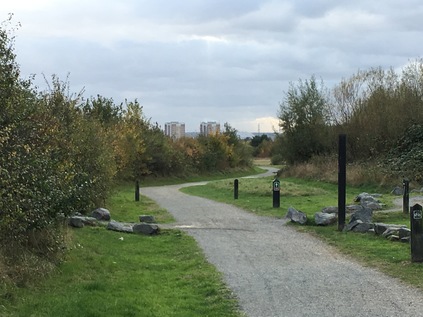
I recalled my imagination from its wandering, and focused on my own journey. Here I faced a final choice about how my walk would end - I could press ahead, return to civilisation and walk on pavement to my destination, or I could turn south again via a gateway in the drive, back into the grassland. I opted for the path to the south, which began as a beaten down edge of a broad field which rose slowly to the south. At the western edge of the field it turned through a gate and became a more formal, rough path which continued to climb towards the southern horizon and, remarkably enough today, a sudden break in the clouds. This was Ingrebourne Hill - not really much of a climb, but by far the highest point around for some distance. The tangle of channels and ponds which the river had become slunk around base of the hill, fanning out to supply the wetlands which carpeted the valley. I soon reached the summit and turned a full circle to take in the view. The clouds had parted to let a golden, autumn sunset begin its gradual progress and the farmhouses and fields which I'd walked from the north were bathed in sudden glamour. The trees, climbed away from the valley towards my starting point - a string of distinct but connected green spaces with the river at their heart. If the plans which the London Borough of Havering have tabled ever come to fruition, this chain of spaces would be broken into parcels, some destined for new development. The green belt unbuckled in the east, the city allowed to leak out towards the skies of Essex. To the south of my hilltop lookout the faint line of the Thames shimmered on the horizon while the factory buildings which lined Rainham Creek towered above the range of pylons and mid-rise housing blocks. To the west, a haze blocked the city from view entirely - but to the east the vast plain of low-lying marshland which stretched along the estuary seemed to run on forever, broken only by the slender grey line of the A13 slinking across its vast, green breadth with a trail of red taillights disappearing into Essex. I trudged downhill, towards the road to Rainham.
Despite having another mile or so cover to reach the station, I was confident I had plenty of time. I was moving more slowly now, heading for the Red Bridge at the roundabout where I knew I'd cross the Ingrebourne for one last time. After paying my respects to the river as it began the final twists towards the Thames, I took a different route to the station from my previous treks, walking along Broadway, Rainham's surprisingly interesting village High Street. The squat, businesslike Norman church of St. Helen and St. Giles stood in simple counterpoint to the formal Georgian brickwork of Rainham Hall sitting upright beside the road. Both faced up against a charming street of homes, shops and inns which seemed to tumble together, some of them in the white painted weatherboard typical of Essex. As I approached the station I pondered if I had time to make good on a foolish promise I'd made to myself before today's late start had interfered with my plans. During a tidy of an old piece of furniture we'd retrieved from my parents' home, we'd found a spare set of keys belonging to my mother. I'd turned the wooden 'Scorpio' imprinted fob in my hand as I'd travelled to London and I'd resolved that the keys should find their final home where I'd tossed Dad's set at the beginning of the year. So, I found myself once again striding out along the path across Rainham Marsh, the bright afternoon sky having turned to a purple-grey churn of cloud with a wild wind thrashing at the stems of reed which lined the Common Watercourse - one of the many channels running into the Thames where it met the estuarial Ingrebourne. I stopped at the spot where I'd gazed across the marshes months ago, and summoned the resolve to slip the pair of keys off their ring. Without daring to hesitate I tossed them into the dark waters, breaking the bright green algae-covered surface. Slowly, the ring of clear water opened up by the keys began to diminish, the green carpet almost covering the surface again. I laughed a little at myself - this strange, sentimental ceremony at a spot which meant nothing to my family as such, but which had come to mean a great deal to me. A place where for centuries people have left the secrets they don't want rediscovered - but for me a place of remembrance. I looked out across the darkening marshes following the line of electricity pylons until it merged into the elevated route of the A13. There was an incomplete walk out there somewhere, but my business here was done. I turned and headed back towards the station, the wooden key fob held tight in my pocket. Back in February leaving the marshes had felt like an ending - when in fact it had been the start of a long year of goodbyes. It had taken me a long time to feel ready to even start saying them.
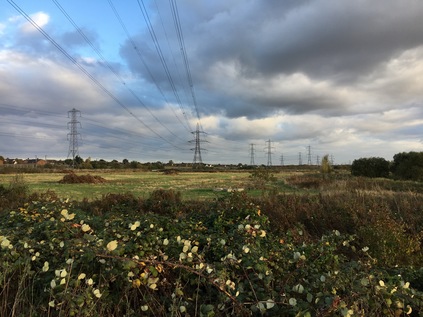
You can see a gallery of images from the walk here.
Lost::MikeGTN
I've had a home on the web for more years than I care to remember, and a few kind souls persuade me it's worth persisting with keeping it updated. This current incarnation of the site is centred around the blog posts which began back in 1999 as 'the daylog' and continued through my travels and tribulations during the following years.
I don't get out and about nearly as much these days, but I do try to record significant events and trips for posterity. You may also have arrived here by following the trail to my former music blog Songs Heard On Fast Trains. That content is preserved here too.

